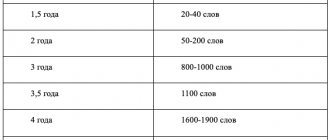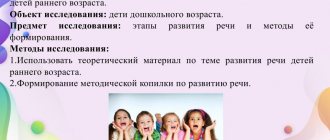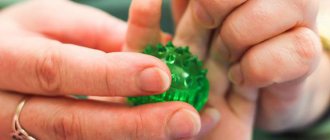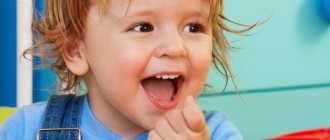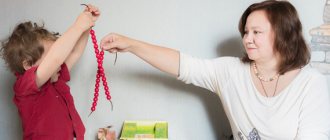A child's first word is one of the most vivid memories of parents. Speech therapist Olga Ivanova talks about what words are most often pronounced at the linguistic start and how to then track the dynamics of oral speech of growing children.
Stokke
Stokke
How do the first words come about?
Every mother eagerly awaits her baby's first words. As a rule, all relatives are involved in the waiting process: mom, dad or grandma - which word will come first? Usually, the winner in this fight is the one who most often stands over the child’s crib, looks carefully into his eyes and clearly repeats: “pa-pa” or “ma-ma.” As a result, the child pronounces the cherished word, and the whole family celebrates the historical event! The child is bathed in applause, and he, satisfied, continues to babble the magical sounds that have caused so many positive emotions in adults. If you continue in the same spirit - look into the child’s eyes, clearly pronounce new words and just as emotionally rejoice at each new one - you will certainly be surprised at the dynamics of your baby’s speech development.
“Why exactly “dad”, “mom” and “baba”? The sounds that make up these words are classified as labiolabial and labiodental. They are formed with the help of lips and voice and are easiest for a child. In order for the baby to also easily develop front-lingual, mid-lingual and back-lingual sounds, add the “horse” exercise: click happily with him,” explains Olga Ivanova.
Literature
1. Ivantsova E.V. Lingvopersonology: Fundamentals of the theory of linguistic personality: textbook. Benefit. Tomsk: Publishing house Tom. Univ., 2010. 160 p.
2. Karaulov Yu.N. Russian language and linguistic personality. M.: Editorial URSS, 2002. 264 p.
3. Lvov R.M. The emergence and development of speech in a child. Factors of human speech development. Periodization of human speech development: Preschool age. School age // L.L. Kasatkin, L.P. Krysin, M.R. Lvov and others. Russian language. M., 1989. pp. 31–32.
4. Lvov R.M. Speech of secondary school students // Dictionary-reference book on Russian language methods. M.: ROST SKRIN, 1997. pp. 185–186.
5. Timofeev V.P. Personality and linguistic environment. Shadrinsk, 1971. 121 p.
6. Chulkina N.L. Idiolexicon of a creative personality and the lexicon of a typical native speaker: the principle of structure, reconstruction and description // Peoples' Friendship University of Russia. M., 1996.
What is active and passive vocabulary?
All the words that a child knows are his vocabulary (lexicon). Moreover, those words that the baby understands, but does not pronounce himself, belong to the passive dictionary. And those words and phrases that are constantly used in everyday speech are included in the active one.
Olga Ivanova: “For example, if you ask a one-year-old child “where is the cat?” and he points to the pet or the corresponding picture with his finger, which means the word “cat” is already in his passive dictionary. When he independently says “cat”, or “koska”, or any other sound that means a cat for a child, we can say that the word has become an active lexicon.”
It is worth noting that the passive vocabulary is always larger than the active one, even in an adult.
After all, each of us knows what society, quantum, molecule are, yet we almost never use these words in everyday speech.
Educational games
A child’s knowledge of the world occurs through games. How can you expand your vocabulary through games?
- "Edible-inedible." Game for children from 3 years old. The presenter (or mother) throws the ball to the child and names the object. If it can be eaten, the baby catches the ball; if the object is inedible, there is no need to catch the ball. You can change the conditions of the game, for example, the participant must catch the ball if the leader calls something soft.
- "Who is bigger". A good game that you can play, for example, in line or on the way to kindergarten. We come up with a category of words, for example, pets. We name domestic animals in turn: dog, cat, cockerel, chicken, cow, etc. The one who remembers the most pets wins. By the way, in this game the mother can give in a little so that the baby feels like a real winner.
- "Children's crocodile." The child chooses some thing or toy, but does not tell the other participants what he chose. Then the baby must describe the chosen item in words, but cannot name it. Then the players change places.
- “Selecting antonyms.” You tell the child a word, and he must choose an antonym: night-day, sun-moon, heaven-earth, evil-good, crying-laughing, etc.
- "Fact or fiction?" You offer your child fictitious or real statements, and his task is to agree with you or find errors. For example, a dog is bigger than an elephant, chickens eat semolina, a dog loves a bone, etc.
The task of parents is to help their son or daughter develop competent, rich speech. To do this, you need to constantly talk with the child, expand his vocabulary, read books, and offer educational games. The more you work with your child on speech development, the easier it will be for him to learn, work and express his thoughts in the future.
leave a comment
How to calculate the volume of active and passive vocabulary?
Finding out the approximate number of words in a passive dictionary is easy. It is enough to ask the child to show a certain object, action, object (for example, a cat). If the child did everything correctly, then the word is counted in the passive dictionary.
Now let’s calculate the size of the active dictionary. What should you consider?
- Words that the child pronounces clearly: “give”, “mom”, “dad”.
- Onomatopoeia for animals and objects: car “beep-beep”, dog “woof-woof”.
- Reproduction of incomplete words: “baka” - dog.
- Words that are pronounced incorrectly, but the number of syllables and stress are correct: “patina” - machine.
- Words that are pronounced the same, but have different meanings (this is the norm up to 2.5 years): “ma” - mom, car, meow (each word is counted separately).
“To make it easier to count active vocabulary and clearly see the progress and dynamics of a child’s development, you need to keep a diary of speech development. Every month you can enter the words that your child has mastered. From 2.5-3 years old, keeping track of every word will be quite difficult due to the growing talkativeness. Then you can write down the baby’s funny sayings in your diary, which you will be happy to re-read in the future,” the speech therapist advises.
Features of speech development in children 3–4 years old
At this age, children's speech continues to actively develop. Children of the fourth year of life begin to draw conclusions and can reason about objects and the phenomena surrounding them. The child is interested in the world of people and things, he is interested in communicating with loved ones and with strangers. The time has come for questions, the answers to which the child, due to his age, is sometimes not able to listen to the end.
Active and passive dictionary
The development of speech for children 3–4 years old leads to the fact that the number of words that children use in speech (active vocabulary) doubles: from 1 thousand words available to them by the age of three, to 2 thousand by the end of the third year of life . Moreover, they not only use them, but inquisitively listen to the meaning of words, and even create their own. “Who called a cat a cat and a hippopotamus a hippopotamus?” Children play with the word, tasting it, rhyming and changing it, coming up with incredible combinations of sounds: milk, toloko, far, coloko; slam, slam, slam, slam.
Long new words, incomprehensible in content, can be pronounced distorted (lipestricism - electricity, lisipede - bicycle), syllables and sounds are often rearranged in them (pervyi - first, gamazin - shop). Combinations of two consonant sounds in a row continue to cause difficulty in pronunciation. In order to pronounce them correctly, the child inserts a vowel sound between them (zinayu - I know), or simply does not pronounce one consonant sound.
Children can already name the details of objects, distinguish externally similar objects, for example, a cup-mug, a tiger-lion. By the age of three, most children should already be able to easily distinguish the animals in the picture below (show it to your child and check):
When learning new words, children of this age establish semantic connections between objects, actions and their names. They begin to think meaningfully about the vocabulary of their native language. However, children's speech is not yet developed enough for full communication. If at the everyday level the baby still has enough mastered words, then they are not enough to retell a long fairy tale or describe a memorable event.
Speech grammar for three-year-old children
The speech of a four-year-old baby consists of phrases. On average, there are 3-4 words in a sentence. At the age of four, they become common, and complex constructions begin to appear - compound and complex sentences. For example: “the doll wants to eat, I’ll make soup,” “when spring comes, the birds fly.”
Children can use singular and plural homogeneous members in phrases. For example, “I draw flowers and clouds”, “the mouse jumps and laughs”. Nouns and verbs begin to give way to their positions; more and more adjectives, adverbs, pronouns and numerals (one, two, three, first, second, third) are found in speech.
But the speech of a 3-year-old child is still imperfect; it is difficult for him to form the plural of many nouns, for example, trees, mouths, sleeves. In coordinating adjectives with nouns, he can also make mistakes, for example, “ripe apple”, “bright sun”.
Often in the speech of children there are incorrect case endings, and the change of the verb in persons and numbers suffers. For example, “I see trees”, “I have a lot of candy”, “children are riding bicycles”. Show the picture below to your child and check this point:
Sound pronunciation
The child grows - his articulatory apparatus becomes stronger, the movements of the tongue, lips, and lower jaw become more accurate and coordinated. A stronger tongue allows you to correctly pronounce previously softened consonant sounds: malyako - milk, syadik - sadik. Long words of 3–5 syllables, as well as words with combinations of two consonants such as bread, class, bottle, are easier to learn.
Most often at this age the following sound pronunciation disorders occur:
- Replacing hissing sounds with whistling sounds: sapka - cap, nozik - knife;
- Unclearly pronounced sound ts, ch: tsyplenok - chicken, prints - prince, tai-chai;
- Absence in speech of the sounds l, r or their replacement with the sounds y, v, softened l: liba - fish, yodka - boat, vozhka - spoon.
If you notice these disorders in your child, you should not worry, but you should consult with a speech therapist. He will always tell you whether this is the age norm, which does not yet require the intervention of a specialist, or not. Although, we must pay tribute, already at this age there are children whose sound pronunciation has practically no defects.
Speech development at 3 years allows for rearrangements and omissions of syllables in polysyllabic words such as hello, please, purple. Such pronunciation deficiencies are successfully overcome by the end of this age period.
The intonation expressiveness of speech is growing - children can imitate adults, adding very expressive notes to the reading of poems by heart and to stories from their own experience. Adjusting the rate of speech and its volume is not always available to children of the fourth year of life. They may speak very quietly, especially when talking to people they don't know. When the impressions of some significant event are too great, the child can talk about them “excitedly,” hesitating and hastily pronouncing words.
A very valuable quality appears - attention to one’s own speech and to the speech of others. Children begin to notice pronunciation deficiencies made by their peers, but less often - their own.
Connected speech
A three-year-old child is not yet able to logically and coherently talk about what he saw, what interested him, or completely retell the content of a work of art read to him. Children of this age are still unable to deliver a monologue on any topic without additional questions. Children's statements are not developed, the phrases are simple and not always connected with each other.
Children cannot compose a coherent story from a picture. They can only list the objects depicted on it and the actions performed by the characters in the image. “There’s a bunny here. He eats carrots. His mother is there. She sits and watches."
Children of this age easily remember and enjoy reciting poems and nursery rhymes that are understandable in content. They can repeatedly listen to the same fairy tale, and then retell its content almost word for word, and the content of some words may be completely incomprehensible to them (bast hut, tar barrel).
How many words should a child have in his active vocabulary?
The norms for the formation of the active vocabulary of a child of preschool and primary school age are as follows:
Thus, if a child normally pronounces no more than 10 words per year, then a child’s vocabulary at 3 years old is already about 1000 words. The vocabulary of a 5-year-old child is already about 2000 words, and the vocabulary of a 6-year-old child is about 3500 words. Don't panic if you suddenly find that your child is speaking fewer words than normal. Each child is individual and develops at his own pace. There are children who begin to speak closer to 2 years, but understand everything already at 1-1.5 years.
If you still have doubts or questions about your baby’s development, for your own peace of mind, consult a specialist. Good dynamics are provided by the inclusion of fun games to develop vocabulary, as well as finger exercises and palm massage. Positive emotions play a very important role: going to the zoo, water park and spending creative time together with parents.
Conversations
From the age of 3, the child already understands the meaning of the text and understands the content of poems and fairy tales that his mother reads to him. Therefore, you can discuss the books you read or the illustrations you viewed. Effective exercises:
- the child tells what is shown in the pictures and makes up stories based on them;
- the child answers questions based on the text he just listened to (good questions: who did you like best? what event do you remember? what would you do in the hero’s place? why?);
- the child describes an object in detail (parents can ask clarifying questions: what shape is it? what color?).
To learn the names of body parts and items of clothing, have your child describe himself or a doll.
Reading fiction
Be sure to read aloud to your child. After all, reading fiction is the most important way to enrich your vocabulary. Children who have loved books since childhood have more developed speech than their peers, are able to construct sentences correctly, and write essays better in school.
When reading a book to your child, try to pronounce words clearly, loudly and correctly, and avoid mistakes in articulation and emphasis. If there are unfamiliar words in the text, explain their meaning to the baby.
Where can I get new words?
This, of course, is communication with parents and other close adults, and then added communication with other children. Interesting games and activities are also important - by expanding our horizons, we expand our vocabulary. What does it mean? At a very young age, every new sensation is recorded by a newly created neural connection in the baby's brain. Over time, everything that he has already learned and will snatch from the world around him in large quantities will begin to be reflected in words. Family traditions and holidays, walks and fairy tales.
“Everything around can become a source of enrichment for a growing person’s vocabulary. The main condition here is that the parent explains, names and shows. And in the future, he answered numerous questions,” explains Olga.
New sensations
Firstly, everything is tactile. Finger paints and various surfaces. Pet fur and rough tongues, sea and sand, pebbles and acorns, spruce branches and food. Plasticine and constructor. This is an inexhaustible source. And also sounds, smells and everything, everything, everything: music and new songs, for example, lullabies. The tastes of food and the smells of flowers - all this gives rise to new connections, new thoughts and requires words, stimulating the child.
Books, stories and games
Parents who read fairy tales and poems, invent nursery rhymes and sing songs are very helpful parents. Enthusiastic grandmothers, aunts, and older brothers and sisters also get involved. It is advisable to choose poems that are age-appropriate, and books with bright and clear pictures.
Travel and dating
Even if the baby just looks at everything and gurgles, new places and people will still awaken the dormant spirit of the explorer in him. The main thing on such trips is to tell and show the child everything, to let them touch what is interesting. And don’t be upset if a brick fence arouses more enthusiasm than a local landmark.
Brothers and sisters
In a large family, younger children usually speak better and start talking earlier because they often interact with older brothers and sisters.
Emotions
Find something that your child likes. A dog, a kettle and a slow cooker with lights, a pair of mom’s rubber boots - if a person is delighted, then you’re doing everything right. And it’s not far from the storm of emotions to its verbal expression.
Is learning languages good for speech?
Early learning of languages helps the development of a child’s speech if this process brings joy to parents and the baby. Therefore, you need to switch to the foreign language that you like best and know best.
Bilingual children begin to speak earlier from birth if both parents actively communicate with them.
“I often compare learning a second language to learning to swim,” Olga explains. If a child begins to master this activity at 3–4 months, then by the age of three he will already be able to swim perfectly independently. Then you can start teaching him how to ski, say. And if you start swimming at the age of three, then, of course, this process will take much longer, and parallel training in different sports can cause certain difficulties. It’s the same with languages.”
Balance of active and passive vocabulary, or why develop speech?
A passive dictionary will always be larger in volume than an active one. At the same time, we should strive to achieve a balance between dictionaries, that is, try to use as many words as possible that we know in everyday speech. And teach this to our children. For what?
In modern society, people who can speak well and interestingly, with developed oratory skills, are valued. The ability to express one’s thoughts clearly and beautifully, captivate the audience, and win the interlocutor to one’s side will help the child in school, in communicating with peers, and throughout life. In addition, an increase in vocabulary entails the development of intelligence, memory, attention, imagination and perception.
A child with a rich vocabulary communicates more easily with adults and other children, and accordingly, adapts better in society. It is easier for such children to learn poetry, solve logical problems, create, and, in general, realize themselves.
What to do if the child does not speak? Read about the signs that should alert parents.
Share your story: when did your child start talking and what was his first word?
- share with your friends!
Experts: Olga Ivanova
Vocabulary composition of the language
VOCABULARY COMPOSITION OF A LANGUAGE - a set of words of a language, the same as vocabulary.
Vocabulary is the most flexible language level. Changes and improvements in the vocabulary of a language are directly related to human production activities, to the economic, social, and political life of the people. The vocabulary reflects all processes of the historical development of society. With the advent of new objects and phenomena, new concepts arise, and with them words to name these concepts. For example, after 1917, the words soviets, collective farm, state farm, middle peasant, Sovnarkom, educational program, Chonovets, etc. entered the Russian language. At different times, they left the language. With the death of certain phenomena, the words that name them go out of active use or change their sound appearance and meaning, for example: thief - 'thief, robber'; guest - 'trader, merchant - mostly foreign'; apple of the eye - 'pupil of the eye'; Komsomol member - 'member of a Komsomol organization', etc.
Freeing the dictionary from unnecessary words (and only those “fall out” from it) is just as natural and necessary as enriching it with new words: it allows speakers of a given language to get rid of unnecessary lexical doublets, eliminate outdated ones from their active vocabulary, and thereby contributes to the more effective performance by language of its main and most important function - to be a means of human communication.
Since the consolidation of new words and meanings in a language, and especially the departure from an obsolete language, is a gradual and lengthy process, in the vocabulary of the language as a whole there are simultaneously two layers of words, see: ACTIVE VOCARIARY and PASSIVE VICTORIARY.
See: VOCABULARY

